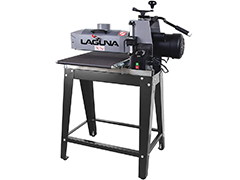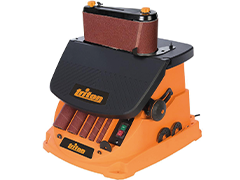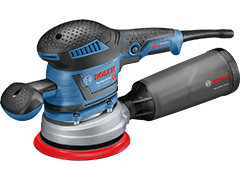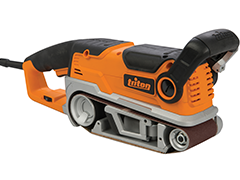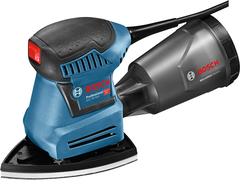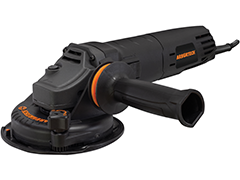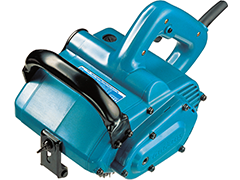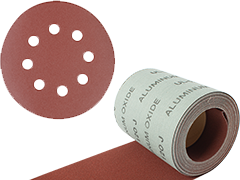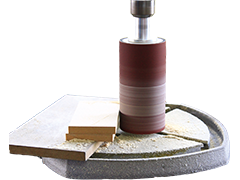- Sanding
Sanding
Next to planing, sanding is the second important process for the surface treatment of wood. Although you will occasionally reach for the sanding block and work manually, the main emphasis is on electric sanders.
Our range includes orbital sanders, random orbital sanders, delta sanders as well as belt sanders from the leading manufacturers. Corresponding abrasives are also available for all machines. The range is rounded off by spindle sanders, polishing machines and satin finishing machines.
Putting the finishing touches on the wood
Sanding is usually one of the later operations in woodworking, but it is also a very important one. It plays a particularly important role in furniture making because it is a decisive factor in the later overall effect of the piece of furniture. Even if one prefers to finally smooth wooden surfaces with a plaster plane and scraper, when applying layer-forming surface agents, one will ensure the desired high-quality result by re-sanding, fine-sanding and possibly fine-sanding. In other areas of woodworking, too, the workpieces are usually finally sanded and not left sawed or planed smooth.
hand sanding
Sanding by hand is labour-intensive and the results are not always as consistent as desired, but sometimes it cannot be avoided. In such cases, you should always use sandpaper with a sanding block, if possible, to avoid unintentionally rounding off workpiece edges or sanding depressions in wooden surfaces. For this purpose, Festool sanding blocks are available with extraction sockets for connection to workshop vacuums so that you do not have to expose yourself to the risks of sanding dust even when sanding manually.
ELECTRIC SANDING MACHINES
In most cases, you will get there faster with less work if you use electric sanders. There are three types of hand-operated machines:
- Belt sanders are excellent for rough and preliminary sanding, for quickly removing large amounts of material and finishing large areas. However, if you upgrade a belt sander with fine sandpaper and sand in the direction of the grain, it can also be very useful for fine sanding of (especially long) workpieces.
- Orbital sanders are often colloquially referred to as Rutschers. They have a flywheel plate on which the sandpaper is placed. The flywheel is rectangular, which makes it easier to work close to edges and corners. A design variant with a triangular flywheel plate is called a delta sander and enables sanding even in very tight corners.
- The random orbital sander is a further development of the orbital sander or the manually guided disc sander, which is hardly ever found any more. Its flywheel is round. It not only vibrates, but also rotates. The material removal rate is lower than with the orbital sander, but the surface quality achieved is correspondingly higher. This is why the random orbital sander is the tool of choice for fine sanding.
STATIONARY SANDERS
Workpieces with internal curves are difficult or impossible to sand with electric sanders. For this purpose, it is better to use a spindle sander. It can be equipped with spindles of different diameters so that small and large curves can be sanded equally well. In addition to the oscillating spindle sander from Triton, we also offer a combination machine (oscillating spindle and belt sander) from the same manufacturer, whose belt sanding unit is particularly suitable for stationary sanding of workpiece edges. Various stationary sanding machines are used in joineries, but their purchase is almost never considered because of their size, acquisition costs and operating costs.
how do you sand wood properly?
The basic procedure for sanding is independent of whether you work manually or with any kind of sanding machine. The material you want to sand also plays only a minor role (more on this below).
When sanding wood, choosing the right grit of abrasive is crucial. It is indicated by a number that is proportional to the number of abrasive particles embedded in a given unit area of the support body. This means that with higher grits (larger numbers), the size of the abrasive particles decreases, i.e. the abrasive becomes finer. Abrasives in grit sizes from 60 to 320 are commonly used for working on wood. However, grits outside this range may be necessary for certain special work. The following table can serve as a guide:
Grit sizes for sanding wood
| Grain | Use | Sanding |
| up to 60 | Sanding off old paint layers and other residues | Coarse sanding |
| 60 | Pre-sanding of solid wood | Rough sanding |
| 60 - 120 | Sanding of milled and planed solid wood surfaces; sanding of veneered surfaces | Pre-sanding |
| 120 - 220 | Sanding of solid wood, veneered and watered surfaces | Resanding |
| 220 - 320 | Sanding of solid wood and veneered surfaces | Fine sanding |
| over 320 | Sanding of primed, intermediate lacquered and final lacquered surfaces | Finest sanding |
The table clearly shows that sanding usually has to be done several times in succession, and with finer and finer abrasives. This is because every abrasive leaves traces in the surface, which are sanded out in the following sanding pass until the desired surface quality is achieved.
With solid wood and veneered wood-based panels, the fine sanding is always carried out in the direction of the grain, as sanding across the grain leaves slight sanding marks.
safety when sanding
Sanding wood produces sanding dust that is extremely hazardous to health. This is especially true for types of wood that contain toxic or carcinogenic substances (such as oak and many exotic woods). Since the fine dust can penetrate deep into the lungs, it is essential to ensure good dust extraction by industrial Vacuum cleaners. For your own protection, you should also wear a respirator or similar. Many users also wear protective goggles to prevent eye irritation.
